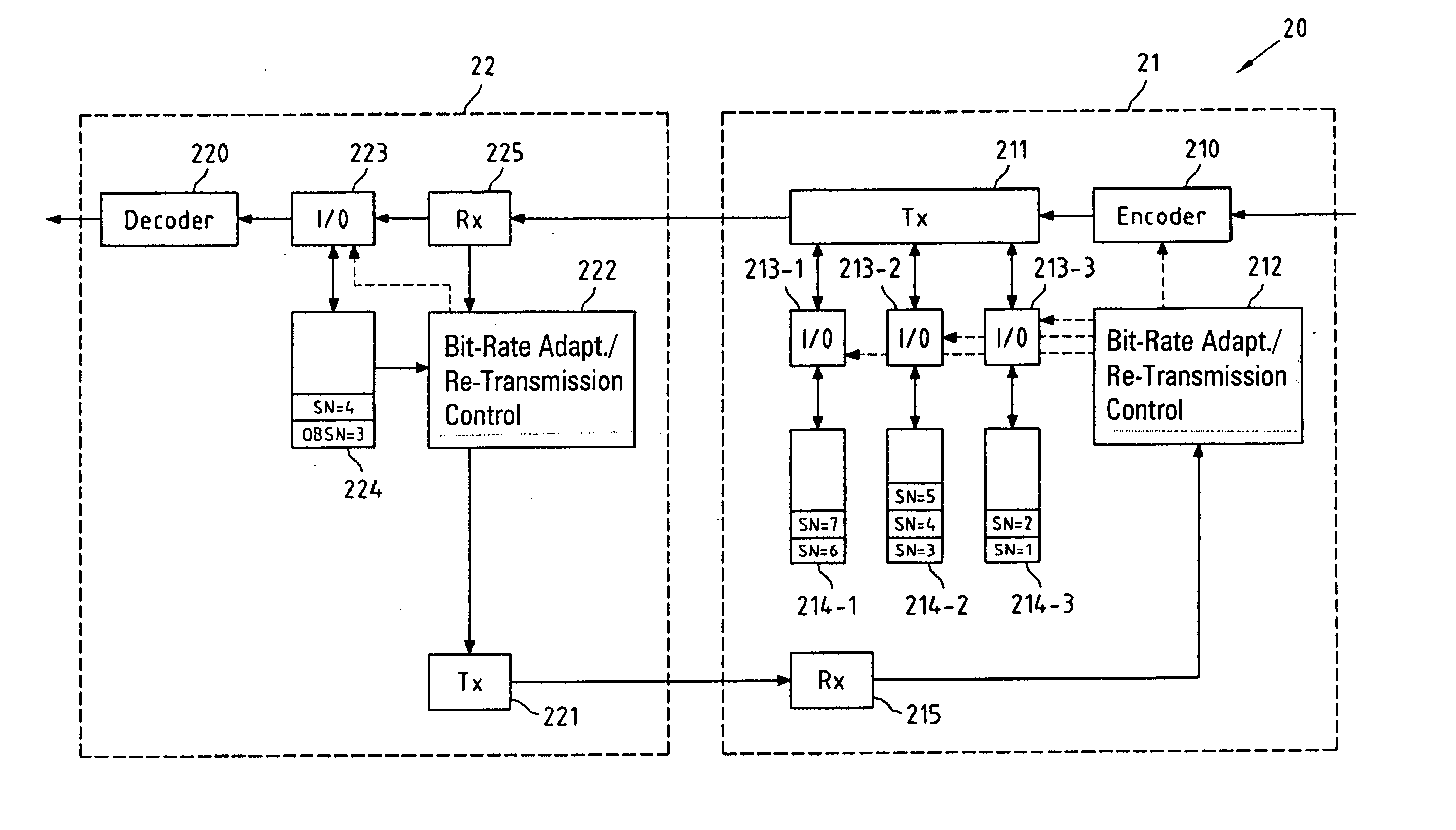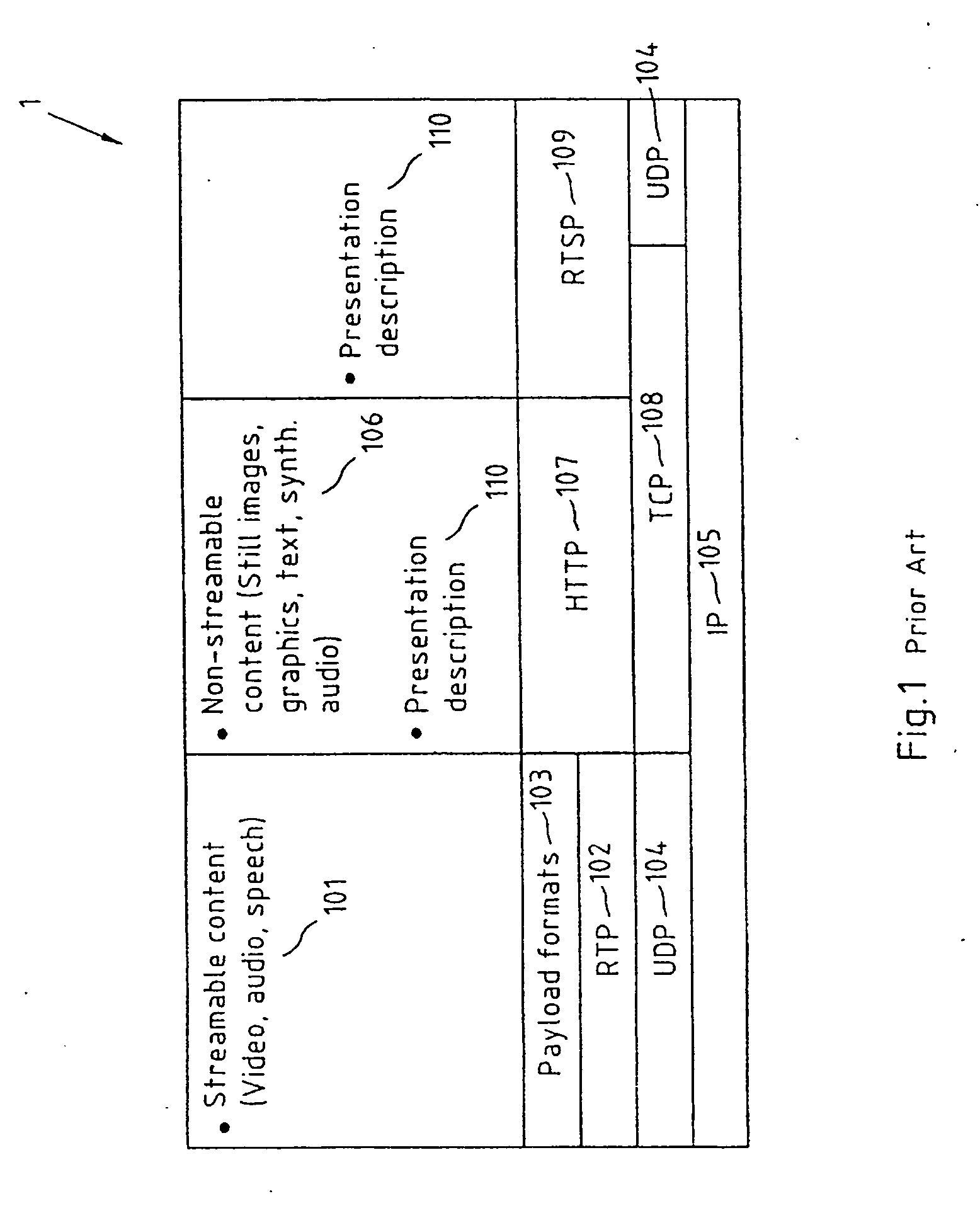[0024] In view of the above-mentioned problems, it is, inter alia, an object of the present invention to provide methods, systems, clients, servers, computer programs and
computer program products for improving a cooperation between a packetized data bit-rate
adaptation and a data packet re-transmission.
[0028] At said client, at least one data packet transmitted to and received at said client is at least temporarily stored in said
client buffer. From said client buffer, stored data packets may be lead to further
processing in said client, for instance, said data packets from said client buffer may be played back by an application. Said client buffer may serve as a compensation buffer that allows the rate with which data packets arrive at said client buffer to vary due to the transmission characteristics (e.g. delay, loss) of the physical and logical
transmission medium between the server and the client.
[0032] According to the first aspect of the present invention, at least one data packet transmitted with said first bit-rate and stored in said server buffer is further stored in said server buffer when said transmitting of said data packets from said server to said client with said second bit-rate starts. Thus when the bit-rate is changed, the server buffer, which contains data packets transmitted with the first bit-rate, is not flushed as in prior art systems. In contrast, the stored data packets transmitted with the first bit-rate are maintained in said server buffer, and are for instance deleted from said server buffer only after a
time duration that may depend on the signaled impairment information. This allows the data packet re-transmission, as far as it is required for data packets that were transmitted with the first bit-rate; to be successfully completed, even when the transmitting of data packets with the second bit-rate already has started. In contrast to prior art, according to the present invention, the case that a corrupted or lost data packet transmitted with the first bit-rate is not available for re-transmission in the server buffer due to a flushing of said server buffer at the instance of a packetized data bit-rate
adaptation from a first to a second bit-rate can no longer occur, thus avoiding delay or break-down of applications fed by said data packets.
[0039] According to a second aspect of the present invention, a method for improving a cooperation between a packetized data bit-rate adaptation and a data packet re-transmission is further proposed, comprising transmitting data packets from a server to a client with a first bit-rate; at least temporarily storing at least one of said transmitted data packets in at least one server buffer; at least temporarily storing at least one of said transmitted data packets in a client buffer; signaling impairment information related to an impairment of at least one of said transmitted data packets during said transmitting to said server; signaling client buffer information related to a state of said client buffer to said server, wherein said signaled client buffer information is analyzed by said server to change said first bit-rate of said transmitting of said data packets to a second bit-rate; deciding, based on said signaled impairment information and said signaled client buffer state information, if a data packet re-transmission is required; and only re-transmitting at least one data packet stored in said server buffer from said server to said client, if it is decided that a data packet re-transmission is required.
[0042] At said client, at least one data packet transmitted to and received at said client is at least temporarily stored in said client buffer. From said client buffer, stored data packets may be lead to further
processing in said client, for instance, said data packets from said client buffer may be played back by an application. Said client buffer may serve as a compensation buffer that allows the rate with which data packets arrive at said client buffer to vary due to the transmission characteristics (e.g. delay, loss) of the physical and logical
transmission medium between the server and the client.
[0046] According to the second aspect of the present invention, a re-transmission of at least one data packet stored in said server buffer from said server to said client is only performed if it is decided that a data packet re-transmission is required, wherein this decision is based on said signaled impairment information and said signaled client buffer state information. In contrast to prior art, wherein the decision on a re-transmission is only based on the signaled impairment information, thus according to the second aspect of the present invention, also the signaled client buffer information is considered in this decision. If for instance said impairment information indicates that a certain data packets needs re-transmission, said client buffer information may nevertheless indicate that this specific data packet does not require re-transmission, for instance because it is already stored in said client buffer, or has already been stored and further processed some time before, or will, even in case of successful re-transmission, arrive at said client to late to be of worth. Thus according to the second aspect of the present invention, unnecessary re-transmissions of data packets occurring in prior art systems that combine data packet re-transmission and packetized data bit-rate adaptation can be completely avoided.
 Login to View More
Login to View More  Login to View More
Login to View More 


